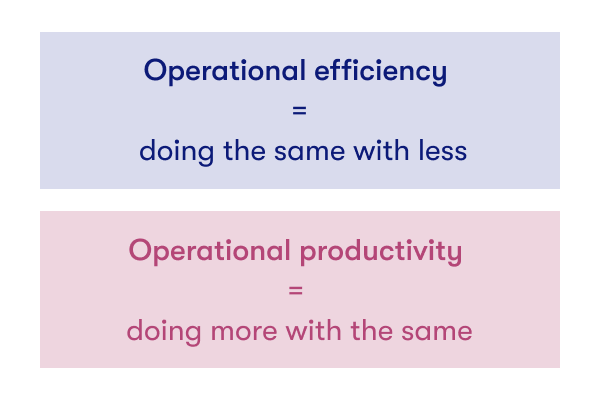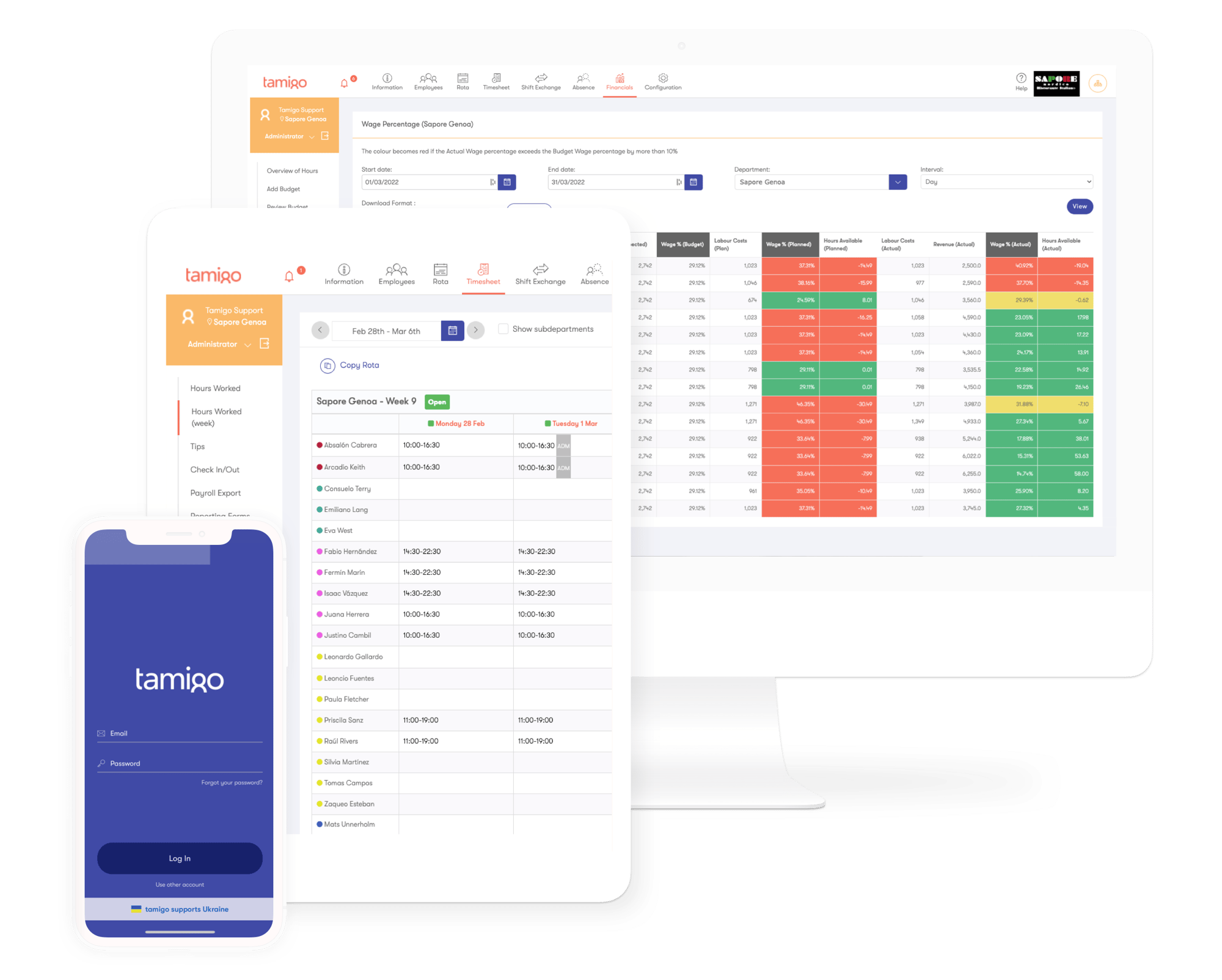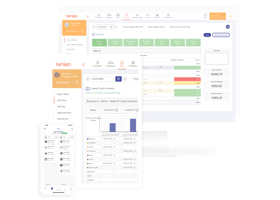
3 ways to improve
operational efficiency
What do successful retail and hospitality companies have in common? They’re focussed on improving operational efficiency. Let’s dig into their reasons, methods, and how they’re using technology to their advantage.

Read More

Read More

Read More

Read More

Read More
Operational efficiency measures the relationship between your business inputs and outputs.
Inputs are the resources needed to keep your business running. That’s everything from hours worked to wages to materials. Outputs are the goods and services you provide.
By improving operational efficiency, you reduce your inputs while keeping your outputs the same. For example, this could mean reducing labours costs without negatively affecting sales.
Operational efficiency vs.
operational productivity
Often used interchangeably, these terms do mean different things.
Operational productivity measures the amount of work done during a set time.
Michael Mankin at the Harvard Business Review has a snappy way of remembering the difference.
Operational efficiency = doing the same with less
Operational productivity = doing more with the same
It sounds simple, but ‘doing the same with less’ can entail a significant new approach to how daily work is carried out. Both for customer-facing employees but also across your whole company.

The benefits of operational efficiency for retail and hospitality?
Inefficient operations waste time, money and effort. These kind of losses aren’t sustainable in retail and hospitality, where margins are tight and competition is intense.
Improving operational efficiency then can be crucial for a healthy bottom line.
Here’s a breakdown of the 3 key benefits.
1. Reduced
labour costs
2. Streamlined
admin
3. Improved collaboration
1. Reduced labour costs
Labour costs are your biggest operating cost.
Efficient planning of your workforce means they’re working when and where they’re needed. And also working on the tasks that make the most sense – if they require special training or certificates for example.
It also takes budgets, demand and availability into account. This way, you avoid costly over- or understaffing.
2. Streamlined admin
Retail and hospitality are plagued by tedious admin. It’s why managers especially spend hours in the back office making shift plans or preparing timesheets.
Outdated systems are usually to blame. But newer systems can be just as guilty if they aren’t serving your needs.
Simplify and automate these tasks to free up mountains of time every month.
3. Improved collaboration
You want everyone working together towards a common goal. But this is challenging when you have multiple locations. Head Office’s strategies and KPIs become inaccessible for managers. And key metrics from your departments get trapped in different systems — not providing any insights.
Operational efficiency gets rid of these bottlenecks. Everyone from HQ and Payroll to managers and employees has access to the data they need, in a way that most benefits their day-to-day work.
How to improve operational efficiency
Putting concrete measures in place to improve operational efficiency seems hard.
Which operational processes should you look at first? And how to go about it in a systematic fashion?
tamigo has been working with retail and hospitality companies since 2006. Over that time, we’ve seen that efficiency drives tend to centre on three key areas: KPIs, scheduling and HR data management.
Let’s look at each one and see the steps your business can take.
You can only begin improving operational efficiency when you have a clear view of your business’s performance. That’s where KPIs come into their own.
What are KPIs (and why are they important?)
KPI stands for Key Performance Indicator.
KPIs are valuable metrics for measuring performance towards a larger goal. They should be relevant, achievable, and most importantly, measurable for whichever stakeholder is responsible for them.
Let’s take an example. Say you run a chain of high-end fashion stores. Your goal is to grow annual revenue by 10%. To your store managers and employees, this goal seems abstract and disconnected from their daily work.
Assigning managers the KPI of Sales-per-Employee makes it more concrete. They can see which employees are selling most, and at what times. It makes it clear how they can schedule their staff to optimise sales, contributing to your goal.
Depending on your type of business, your KPIs will be different. Read on for some examples from the different industries are customers operate in.
KPIs for retail
Every retailer’s goal is to run cost-effective, productive stores. KPIs are key here. They give you a more detailed picture of labour costs and revenue.
In today’s landscape of labour shortages, there’s also increasing emphasis on the staff’s engagement. Tracking KPIs like staff turnover rates helps HR spot areas for improvement in the employee experience.
- Wage Percentage: Labour costs as a percentage of revenue.
- Sales per Total Hours: Sales generate in all hours (both productive and unproductive).
- Off-floor Percentage: Unproductive hours (e.g., admin time) vs. total hours.
- Staff Turnover Rate: Number of leavers compared to total employed.
- FTE per Activity: Full-time equivalent hours spent on different tasks (e.g., replenishment).


KPIs for hotels
In many ways, hotels are 4 or 5 businesses in one. There’s Housekeeping, F&B, Front Desk... the list goes on. Each department measures success in different ways.
GMs can’t be everywhere at once, so setting KPIs for Heads of Department to follow helps consolidate operations. And it makes collaboration and reporting across every department much more transparent.
Some selected KPIs for hotels:
- Revenue per Available Room (RevPAR): Total room revenue divided by available rooms.
- Occupancy Rate: No. of occupied rooms divided by no. of available rooms.
- Average Length of Stay (LOS): Occupied room nights divided by no. of bookings.
- Rooms Cleaned per Staff per Day: Total no. of rooms cleaned divided by total no. of housekeeping staff.
- Labour Costs Planned vs. Actual: Planned hours as compared to those that were worked.
KPIs for restaurants
Making a restaurant a success is incredibly challenging. There’s the razor-thin margins, long hours and diners’ ever-changing tastes to contend with.
In this whirlwind environment, KPIs bring stability, providing a financial framework that works for both FOH and BOH. For businesses which live in the moment, having data to back up snap decisions (“do I need to call someone in tonight to help out?”) is a gamechanger.
Some selected KPIs for restaurants:
- Table Bookings: Expected no. of guests for a specified time period.
- Table Turnover: Total dining time divided by no. of guests.
- Cost of Goods Sold (CoGS): Original inventory plus purchases minus closing inventory.
- Campaign Product: Budgeted vs. actual sales for campaigns/promotions.
- Absence Percentage: No. of absent hours compared to all hours.

Why you need KPI software
Choosing your KPIs is one thing. Tracking them — and making them accessible to the right stakeholders — is another. Leave them to sit in a sporadically updated spreadsheet and you might as well not have them at all.
Fortunately, the growing market for cloud-based workforce management (WFM) systems offers a solution.
These software combines scheduling, time and attendance, absence management and more. And they enable businesses to work real-time KPIs into daily routines.
An obvious example would be a manager planning next week’s schedule. With WFM software, KPIs can be displayed to them as they create schedules. Every time they move a shift around, they see the instant impact on KPIs like Wage Percentages, Available Hours and Productivity.
With this approach, it’s also easier to report on KPIs. Because everyone has access to the same solution. A regional manager can always see current Sales per Total Hours per location. While HR can find and export Staff Turnover for their German and Spanish operations — ready to export to their global BI system.
Base data behind these KPIs (think budgets or sales figures) is generally imported into your WFM solution. This can be done manually via Excel files, or through integrations with other systems, such as your POS, HCM or Guest Reservation software.
With KPIs accessible and usable in this way, you foster a forward-looking working culture — focussed on improving efficiencies, rather than just reviewing past performance.
Effective resource allocation is fundamental to boosting your business's operational efficiency. Demand-oriented workforce scheduling has a significant impact on overall efficiency. After all, it optimises resources and increases productivity throughout the company.
How scheduling impacts efficiency
There’s so many elements to consider when scheduling staff: Availability, labour laws, budgets, and not least of all, the number of customers you expect at any given time.
Get these elements out of balance and you’ve got problems. The two most common: Under- or overstaffing.
Understaffed locations drain employees’ morale and curb your number of potential sales. Not to mention harming your brand’s reputation in the eyes of frustrated customers. And if you’re overstaffed? Then you’re paying out wages to staff who have nothing to do.
Make schedules that slot all these elements together and you’ll boost efficiency. Employees are working productively, where and when they’re needed, and have the time to give stellar customer service. Discover how to schedule employees effectively.

Efficient schedules in retail
Retail employee turnover has always been on the high side. But in recent years it’s reached new peaks across Europe. In Germany for example, as many as 1 in 3 businesses found themselves affected by staff shortages.
Flexible scheduling helps reverse this trend. This approach, common in Scandinavia and now spreading across Europe, gives staff more input into shift planning, so their preferences are respected. This builds trust and engagement. And engaged employees are less likely to look for other jobs.
One retailer that took this route is Salomon, the popular Frech outdoor sports brand. Salomon transitioned from rigid Excel-based schedules to a WFM solution. Employees got flexible scheduling tools like shift swaps and bids and a clear view of upcoming hours — all in a user-friendly app.
Something else that might interest you: Reduce staff turnover in supermarkets with smarter scheduling.
Keeping costs under control with restaurants schedules
We’ve all eaten at restaurants where one waiter is rushing around to serve 20 different tables. It’s a poor experience for both them and us. For the restaurant business, it impacts upsell opportunities, table turnover rate and the chances of repeat business.
By scheduling staff based on real demand, you’ll have enough hands during busy times. And fewer during the slow ones. This way you keep labour costs under control while maximising your sales opportunities.
Integrating table bookings into your scheduling is a great first step. It lets managers plan more accurately to the anticipated number of guests. With this foundation in place, they can make in-the-moment calls on who to call in or send home with confidence.
Want to discover more tips for better restaurant operations? Check out How restaurants control costs with workforce management software.


Smarter employee schedules in hotels
Hotels experience wild swings in demand across the year. This must be factored into schedules. Otherwise service levels are going to suffer.
We can look to Germany’s Hotel des Nordens for inspiration.
Back in 2010, the hotel prioritised demand-based staff scheduling by adopting tamigo. Suddenly instead of static spreadsheets, department managers could see real-time numbers like flex levels, which is how much time each employee is over or under their contracted hours.
“At the end of the week, they can see the current flex level of the employees and have control over all wage limits – without having to do the calculations themselves. If an employee has a lot of overtime and there's not much to do in a week, they know who can be scheduled for fewer hours without having to spend a lot of time digging.” Ronny Wile, Administrative Manager, Hotel des Nordens
The best scheduling software
and tools
Planning shifts can take hours out of your week. This is especially true if you rely on spreadsheets or ill-fitting systems.
But shift planning doesn’t have to be so daunting. Modern employee scheduling software offer a range of features to life the weight of your shoulders. These include automations, which can generate shifts for the weeks ahead based on your ideal number of employees per hour. You can base this ideal number sales or customer footfall data you import into the solution.
There’s a lot of options out there when it comes to software — from free online tools to cloud-based suites.
It all comes down to your specific requirements. Do you want to plan with the help of KPIs? Will your scheduling need to integrate to an existing time clock system?
You can discover tamigo, one of the market’s most comprehensive scheduling solutions, here. See why it’s trusted by customers like Marriott, Intersport and McDonald’s.
What about AI scheduling?
ChatGPT was launched in late 2022. For most of us, it was the first time we’d had hands-on experience with AI. It sparked a scramble to incorporate AI into every workflow and business process.
AI’s potential for scheduling is inspiring, but here at tamigo we believe that a human should still have the final sign-off.
To this end, we’ve partnered with RELEX Solutions. RELEX is the market leader in retail and supply chain planning. Through our integration, RELEX’s AI-driven workload forecasts and optimisations feed into tamigo’s shift generation tools, ready for planners to use and validate.
It’s an opportunity that Finnish pharmacy chain Yliopiston Apteekki took on. One of the country’s best known healthcare brands, they have 17 locations and over 1000 employees to schedule.
“With the new end-to-end solution, Yliopiston Apteekki can leverage machine learning to generate accurate workload forecasts and optimal shifts,” says Sami Laine, HR Director at Yliopiston Apteekki. “It also empowers our employees to carry out their essential workforce functions, such as shift swapping, time and attendance and absence management, with ease.”
Streamlining internal company workflows plays dividends when it comes to operational efficiency.
Here’s how your HR team can make the biggest impact.
Why HR management matters
HR is the backbone of retail and hospitality businesses. It's not just about hiring qualified employees and getting paperwork done. It’s also developing processes that inspire and engage your workforce.
When employees feel valued and receive proper training, they naturally offer exceptional service, fostering customer satisfaction and loyalty. Additionally, robust HR management is fundamental in ensuring compliance with local labour laws.
However, balancing the expectations of employees, senior leadership and compliance demands can be challenging. And many businesses still rely on outdated methods, navigating through spreadsheets and paperwork.
By streamlining HR management and reporting, your business can avoid the pitfalls of manual and inefficient workflows — unlocking a host of benefits crucial for boosting operational efficiency:
- Consistent and accurate reporting
- Mitigation of payroll and benefits errors
- Compliance with different local regulations
- Enhanced employee satisfaction and reduced turnover rates
Speed up processes with automated document generation
Automated document generation fits right into the lean operations that fuel the efficiency and growth of your business. They not only free up your HR team's time but also drastically reduce the turnaround time of processes.
This is especially valuable during recruitment. Take for instance digital signatures. With the electronic equivalent of traditional written signatures, new hires and managers can sign in minutes, not the hours or days it takes when contracts are sent via email or post.
Just like their manual equivalent, they are legally binding. Plus, far more transparent. Instead of being filed away on an office shelf, signed docs are available online — readily accessible to the relevant stakeholders. Learn more about the benefits of using digital signatures in your business.
Drive business value with HR analytics
Analytics guide better decision-making. This holds for HR as well.
McKinsey reports that HR analytics can boost hiring efficiency by 80% and enhance company productivity by 25%. As a result, more retail and hospitality companies are embracing HR analytics, or people analytics, to boost efficiency.
In these industries with diverse workforces, including part-time, full-time, and contractual employees, finding effective workforce strategies can be tough. By analysing a spectrum of parameters, encompassing customer feedback, sales productivity, and performance metrics, HR analytics offers a comprehensive view. This empowers swift and accurate identification of inefficiencies for agile operational improvements.
Armed with this data, businesses can improve processes, optimize workflows, and foster better teamwork. And also, beyond HR, people analytics impacts various aspects of business operations:
- Reduced turnover
- Drive profitability
- Streamlined performance management
- Improve real-time decision-making
Increase success with HR reporting software
For retail, restaurant and hotel businesses looking to continue evolving in today's digital era, the need for reliable and efficient HR software has become more critical.
Especially HR reporting software plays a pivotal role in enhancing operations.
These industries thrive on the effective management of diverse workforces, making precise insights and streamlined processes imperative.
HR reporting software isn't just about automating reports; it's a data-driven powerhouse that allows you to drill down on the HR data that matters.
As such it provides critical insights for informed decision-making, significantly impacting operational effectiveness.
Let’s look at some of the benefits of modern HR reporting software:
- Informed decision-making. It delivers in-depth analytics on workforce performance, enabling your business to spot trends and patterns, track key metrics, and make informed decisions.
- Efficient operations. The automation of your reporting processes will save you tons of time and minimise errors, leading to smoother operations.
- Compliance across the board. Modern HR reporting software like tamigo allows you to configure your solution to the individual needs of the markets you’re operating in. Your employees will be able to use tamigo in 20+ languages. We will ensure compliance with labour laws and industry regulations to in-depth expertise about different markets.
Mastering data with BI integrations
In HR, data in the form of reports, budgets and various metrics is key to increasing operational efficiency and gaining a competitive advantage. However, managing this flood of data and drawing actionable conclusions can quickly overwhelm HR departments - especially if it is done manually and with time-consuming spreadsheets.
This is where Business Intelligence (BI) software comes into play.
BI systems offer advanced capabilities that give your HR department a new perspective on data. These platforms allow for a holistic view and empower HR teams to gain insights into key metrics, predict trends and make informed, actionable decisions.
However, integrating a BI system requires careful consideration. When seeking to implement a BI solution, look out for two things:
- Compatibility: Ensure compatibility and seamless integration with your existing HR system, allowing for a unified and comprehensive data ecosystem.
- Usability & Accessibility: Prioritize user-friendly interfaces and accessibility across different levels of the organization, enabling easy adoption and utilization of the BI system by various stakeholders.
From our experience working with retail and hospitality brands, we’ve seen that improving operational efficiency takes time and focus.
But with a WFM software, you’ll begin to feel the benefits almost immediately. The most obvious is that the same schedule is available to everyone. Whenever a change is made, it’s immediately visible to managers, employees and every other relevant department. Most solutions also offer a smartphone app, so you can stay up to date on-the-go.
But that’s just the beginning. WFM can handle all three operational areas we’ve covered — KPIs, scheduling and HR data management — making it the perfect tool build your operational efficiency efforts around.
tamigo’s cloud-based WFM solution is an essential part of daily operations for businesses across Europe.





